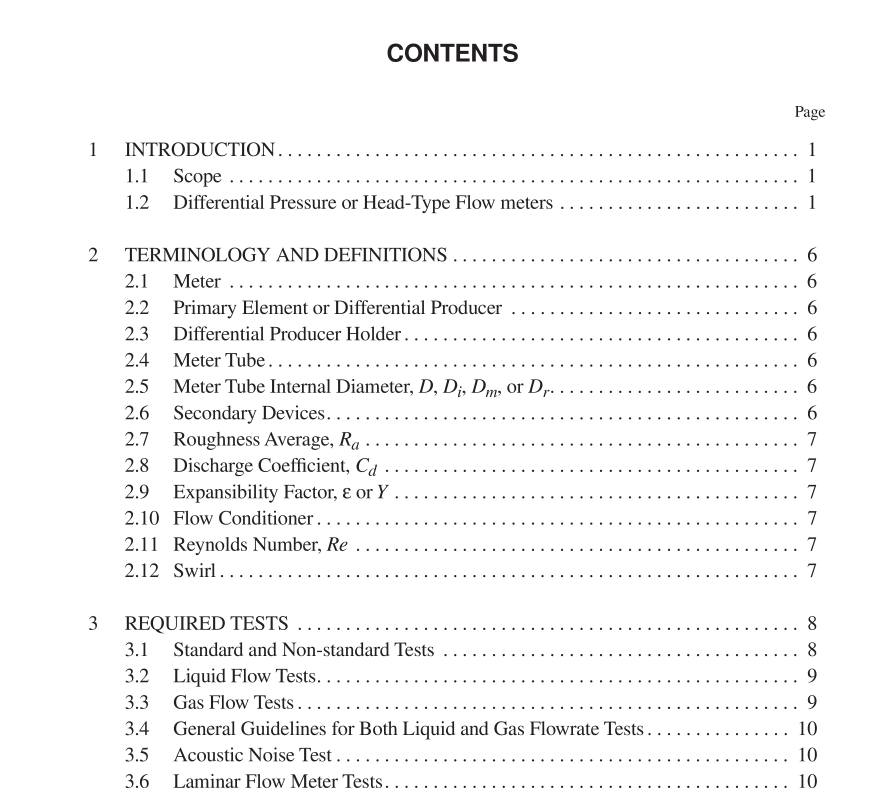API MPMS 5.7 pdf download

API MPMS 5.7 pdf download.Manual of Petroleum Measurements Standards
1 Introduction
This document defines the testing and reporting protocols for flow measurement devices based on the detection of a pressure differential that is created by the device in a flowing stream. These protocols are designed to supply industry with a comparable description of the capabilities of these devices for the measurement of single-phase fluid flow when they are used under similar operating conditions. The objectives of this Testing Protocol are to: 1. Ensure that the user of any differential pressure flow meter knows the performance characteristics of the meter over a range of Reynolds numbers as applicable or defined by tests, 2. Facilitate both the understanding and the introduction of new technologies, 3. Provide a standardized vehicle for validating manufac- turers’ performance specifications, 4. Provide information about relative performance charac- teristics of the primary elements of the Differential Pressure metering devices under standardized testing protocol. To accomplish these objectives, the testing protocol defines the test limits for operating conditions of the meter, the requirements of the facility or facilities to perform the tests, the fluids to be tested, and the ranges for pressure, differential pressure, temperature, secondary instrumentation and Rey- nolds number.Examples of flow meters covered in this standard include, but are not limited to orifice plates, Venturis, nozzles, V- Cones, wedge meters, and averaging Pitot tubes. Reporting and testing protocols for test facilities are included to ensure that the performance characteristics of each meter are com- pared with identical conditions as set forth in this standard. These protocols require descriptions of the test fluids to be used, the mechanical configuration of piping, effects of fluid flow profile and spatial orientation of the meter. A description of required dimensional measurements and tolerances and the mathematical equations required to convert the differential pressure reading to a flowrate prediction is also necessary. This document primarily addresses testing protocol for differ- ential pressure flow meters that operate under the flowing condition that is in the turbulent flow regime. The differential pressure flow measurement devices that operate on the princi- ple of physical laws of laminar flows require special testing protocol, which is addressed in Section 3.6.
1.1 SCOPE
The protocols are limited to single-phase Newtonian fluid flow, and no consideration is given to pulsation effects. Fur- ther revisions of this document may include the testing of such meters in wet gas or multi-phase service and the effects of pulsation. This standard does not address testing protocols of those devices that operate on the principle of critical or choked flow condition of fluids. The testing protocol covers any flow meter operating on the principle of a local change in flow velocity, caused by the meter geometry, giving a corresponding change of pressure between two set locations. There are several types of differen- tial pressure meters available to industry. It is the purpose of this standard to illustrate the range of applications of each meter and not to endorse any specific meter. The basic princi- ple of operation of the flow measuring devices follows the physical laws relating to the conservation of energy and mass for the fluid flows through the device. Any existing or later developed API MPMS document addressing a specific type or design of differential pressure flow measuring device will supersede the requirements of this document. Example of one such existing standard is API Manual Petroleum Measurement Standards Chapter 14.3— “Concentric, Square-Edged Orifice Meters.”
1.2 DIFFERENTIAL PRESSURE OR HEAD-TYPE FLOW METERS
The operating principle of a differential pressure flow meter is based on two physical laws—the conservation of energy and conservation of mass, where changes in flow cross-sectional area and/or flow path produce a differential pressure, which is a function of the flow velocity, fluid path, and fluid properties. The following diagrams are presented as examples of the some of the possible differential pressure devices. Other variations of meter designs are available and possible.









